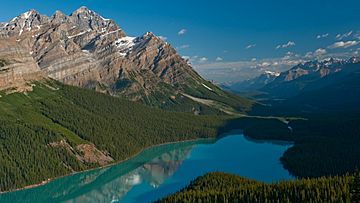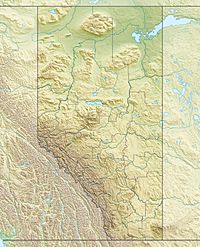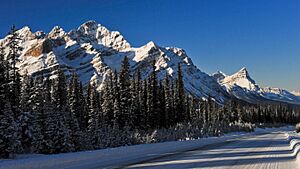Mount Patterson facts for kids
Mount Patterson is a tall mountain in the Canadian Rockies. It is part of the Waputik Range and can be found inside Banff National Park in Alberta, Canada. This mountain is a famous sight from the Icefields Parkway. It stands across the Mistaya River Valley from Mount Weed.
Quick facts for kids Mount Patterson |
|
|---|---|

Mount Patterson reflected in Peyto Lake
|
|
| Highest point | |
| Elevation | 3,197 m (10,489 ft) |
| Prominence | 810 m (2,660 ft) |
| Parent peak | Mount Balfour |
| Listing | Mountains of Alberta |
| Geography | |
| Location | Alberta, Canada |
| Parent range | Waputik Range |
| Topo map | NTS 82N/10 |
| Climbing | |
| First ascent | 1924 F.V. Field, W.O. Field, Edward Feuz Jr. |
| Easiest route | The Snowbird Glacier and East Face IV 5.6 |
Mount Patterson is a tall peak in the Waputik Range. This mountain range is part of the larger Canadian Rockies. The mountain is located within Banff National Park. This park is in Alberta, a province in western Canada.
You can easily see Mount Patterson from the Icefields Parkway. It stands across the Mistaya River Valley from Mount Weed. The closest higher peak to Mount Patterson is Howse Peak. It is about 10 kilometers (6.3 miles) to the northwest.
Naming the Mountain
Mount Patterson was named in 1917. It was named after John Duncan Patterson. He was the president of the Alpine Club of Canada. He led the club from 1914 to 1920.
How Mountains Form: Geology
Like other mountains in Banff National Park, Mount Patterson is made of sedimentary rock. This type of rock forms from layers of sand, mud, and tiny bits of plants and animals. These layers built up over millions of years in ancient shallow seas.
The rock layers were laid down during the Precambrian to Jurassic periods. This means they formed a very long time ago. Later, a huge event called the Laramide orogeny happened. During this time, powerful forces pushed the rock layers eastward. This caused them to fold and break, creating the tall mountains we see today.
Weather and Environment: Climate
Mount Patterson is in a subarctic climate zone. This means it has very cold, snowy winters. The summers are usually mild.
Temperatures can drop below -20 degrees Celsius (-4 degrees Fahrenheit). With the wind chill, it can feel even colder, sometimes below -30 degrees Celsius (-22 degrees Fahrenheit). Snow and ice melt from Mount Patterson. This water then flows into the Mistaya River. The Mistaya River is a smaller river that eventually joins the larger Saskatchewan River.



